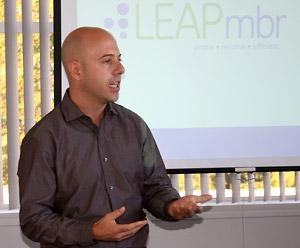by Laura Walz [email protected] Membrane technology used in the Westview wastewater treatment plant has been improved and costs less than it used to, according to a representative from GE Water and Process Technologies.
Miles Sherman, regional sales manager for GE, provided an overview of the technology during a City of Powell River committee-of-the-whole meeting on October 20. The Westview plant uses membrane filters manufactured by Zenon Environmental. “When Zenon got involved with Powell River going back 15 years ago, it was a young, fledgling Canadian company that had a great technology that has since then proliferated through the world,” said Sherman.
Sherman said he used to work for Zenon, which GE purchased. GE now has 65 plants throughout the world using the same technology that is in the Westview plant, he said. The plants treat between four MLD (million litres per day) to 20 MLD. The smallest size is about what Powell River’s facility treats on a small day, he explained. There are over 25 plants treating over 20 MLD, he added. As well, he said, there are over 90 membrane facilities in Canada.
When Powell River’s plant was commissioned in 1998, it was the largest facility using membrane technology in the world, Sherman said, treating an average of four to five MLD, with peaks up to 13 MLD. The largest wastewater treatment plant using that technology will be in Brightwater, just outside Seattle, in the United States, Sherman said, which will treat 144 MLD when it is completed next year.
In 1997, the city entered into a $4.95 million design-build contract with Hill Murray and Associates, a company from Victoria, for what was considered a “state-of-the-art” wastewater treatment plant. The cost quickly escalated to $6.3 million, the plant was never able to consistently meet provincial permit requirements and three different reports outlined its deficiencies, which included problems with the grit removal and handling system; the capacity of the membrane system; odour control; and structural, electrical and mechanical deficiencies. A completion schedule agreed to by Hill Murray and the city identified 35 outstanding issues and deficiencies. Several of those issues were never resolved and both Hill Murray and the city launched legal actions. They eventually settled the contract in 2000.
Only a small percentage of the sewage flowing into the plant is treated by the membranes, Sherman explained. The rest bypasses the membranes, flows through a screen and is then combined with the membrane-treated flow. The blended flow often doesn’t meet permit requirements. Sherman said that when the percentage of untreated flow is over 30 to 40 per cent of the membrane-treated flow, problems with not being able to meet permit requirements arise. If all of the flows were treated through the membranes, the treated effluent would be well below permit requirements, he said.
GE just launched a new membrane bioreactor at a conference in Los Angeles, Sherman said. If that were used in the Westview plant, there would be a 50 per cent reduction in membrane aeration equipment and 90 per cent energy reduction. The advantages of using a membrane bioreactor include a smaller footprint compared to a conventional activated sludge process and equivalent lifecycle cost to conventional treatment.
Costs for the technology have decreased significantly, Sherman said. “For a 20 MLD plant today, our capital installed costs would be less expensive than a comparable conventional treatment plant,” he said. He estimated the membrane equipment alone for the Westview plant to treat all the flows would cost about $3 million.
Sherman’s presentation addressed only using GE’s new membrane technology to treat sewage flowing into the Westview plant. In its liquid waste management plan, the city has to consider the Townsite treatment plant as well, because it discharges sewage sludge after treatment into the Strait of Georgia. While that is in accordance with its existing permit, the ministry of environment has said the plant needs to be upgraded or replaced.



